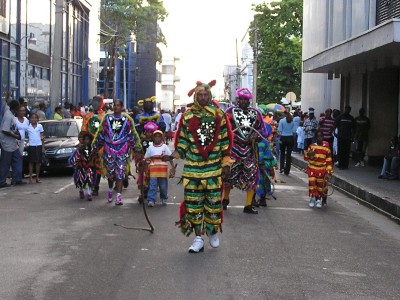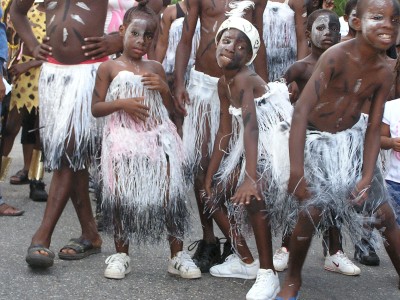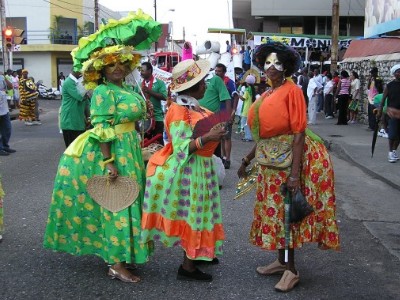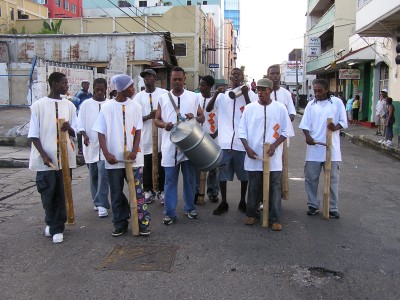|
|
|
The Art of Trinidad and Tobago
|
Trinidad Carnival: Afri-Caribbean Resistance
By Corey Gilkes
February 23, 2003
 Jab Jab - Pretty Devils : Photo credit Christine
Jab Jab - Pretty Devils : Photo credit Christine
Carnival is colour, no doubt about that. Carnival is revelry, gay abandon a period when sexual inhibitions are lowered, all this is true. The "Mas" has also become very much a world festival: a period where the creative genius of people no matter what ethnic background, can be showcased for the entire world to admire, but Carnival as a forum for resistance to oppression? Many people familiar with the Carnival celebrations of Trinidad, Cuba, Brazil, New Orleans, Labour Day celebrations in the US and other places know about a wild, colourful, celebration just prior to Ash Wednesday. What is not so well known is that this colourful festival also served as a medium for resistance to white domination, particularly when one considers that the ways in which the British imposed their authority and "superiority" was [sometimes] much more sophisticated and subtle than the blatant thuggery that characterised North American racism. What is even more obscure is the actual origin of this festival.
I wish to highlight the history of the African in this part of the Caribbean and their passive [and sometimes active] struggles by highlighting the festival and the musical tradition Trinidad is most famous for - Carnival
and calypso, since the history of our struggle is incomplete without an inclusion of these two traditions.
Origins
I wish to set the stage, however, by giving an explanation about carnival and calypso, what they are and where did they really come from. I think it is important that I do this for the benefit of those who do not know anything about what I'm speaking about and also for those who do know about or celebrate some pre-Lenten festival or ancient fertility custom and did not realise that they are all linked. Also, some misconceptions that have been allowed to continue in spite of the extensive documentation of carnival traditions need to be cleared up. Now most people who have written about the many pre-Lenten carnival traditions around world usually credit the ancient Romans with the origins of the festival and the French for spreading it. This is because most of them, whether consciously or not, were Eurocentric in their outlook. The confusion is compounded by the name CARNIVAL, which comes from a Roman expression that means 'farewell to the flesh'. Confusion is also compounded by the fact that this festival is associated with the ancient deity Bacchus [from which we get the name "bacchanal"] However, while there are clearly Roman and French influences in the festivals of New Orleans, Rio, Trinidad, etc., the roots of these pre-Lenten festivals lie in Africa where, ironically, it had nothing to do with Lent at all.
 Children portraying Zulu Warriors : Photo credit Christine
Children portraying Zulu Warriors : Photo credit Christine
It will appear strange to some that Africa has anything to do with the carnival traditions they participate in. It may be even more surprising to know that in Africa, these festivals are still being celebrated in most West African states, such as the Egungun festival of Nigeria. Depending upon where one goes it lasts anywhere between 17days to three months [ie from March to May]. In these festivals we see all of the elements that go into the 'Mas of Trinidad, Cuba, Rio-de-Janeiro: - reversal of social station, gay revelry, pantomime, street parades, hand clapping, music and masking. The use of the mask is as old as humanity; people wore animal skins and heads and "became" the deity or totem they represented. They took on the attributes of their totems, personified their ancestors, and wore distorted masks to portray supernatural beings. We find the use of masking in ancient funerary rites, yam and rain festivals and initiation rites. In the Egungun festival of Nigeria as well as the festivals held in Senegal, Benin, and many other parts of Africa, characters that can be identified with similar characters in Trinidad: the moko-jumbie stilt walker, a type of Dame Lorraine, griot court singers [who is the calypsonian in Trinidad] and devils. Even the hat worn by our Midnight Robber is worn by high priests and priestesses of the Yoruba.
Even the European version of the festival has some interesting revelations; the Romans celebrated Saturnalia and the Lupercalia festival - pre-Lenten festivals dedicated to Bacchus. These were characterised by wild licentious celebrations. Young men would run naked through the fields with leather straps to strike any young woman they would run across, and women would be raped openly in the streets. These wild festivities diffused to Rome via the Greek Dionysian festivals and Arcadian shepherds who in turn copied the festival from the spring solstice celebrations of Egypt. As far back as 525 BCE Greek historian Herodotus wrote in Book II of his "Histories" that the festivals to Bacchus were copied from Egypt as well as the names of the Greek deities [For Classical accounts refer to Herodotus and Ovid]. This was the Egyptian celebration for the fertility of the earth and women and to mark the opening of their crop season.
These were joyous, yet solemn occasions, with men parading through the streets, each one holding a phallus as a sign of homage to womanhood [Pissenlit a carnival character that was outlawed in Trinidad in the 19th century, bears faint resemblance to this ancient phallic procession]. The ancients did not view the human body and sexuality in the same schizophrenic way the West did. In fact, it is ironic that such a festival in Classical Greece could be identified with a deity who freed women when most of our present day chauvinism can be directly traced back to the patriarchal cultures of Greece and Rome.
Researchers like Robert Tallent show that the Egyptians held many festivals honouring the changing of the seasons, beginning and end of crop season, initiation and funerary rites. Among the many calendrical festivals were the festivals of Opet, held in the first month when the inundation of the Nile forced a halt to agricultural work; the harvest festival of Min when the deities of fertility were praised; the funerary Drama of Yusir/Osiris - commemorating the death and resurrection of Yusir; the Sed festival which marked the rejuvenation of the Pharaoh; irrigation rites held in August when the irrigation canals were opened to let the waters of the Nile flow into the interior (interpreted as the union of Yusir and Auset/Isis). There were also royal accession rites and festivals honouring the priesthood.
19th century curator of the British Museum, EA Walli-Budge has described some of these festivals in several works. In this excerpt from "Osiris and the Egyptian Resurrection", he writes about a Passion festival dedicated to Yusir:
[A] procession formed of priests and the ordinary people. Ap-uat walked in front, next came the boat containing the figure of the god and a company of priests or "followers" of the god, and the rear was brought up by a crowd of people……The boat of the god was then attacked by a crowd of men who represented the foes of Osiris……A solemn service was performed in the temple before the body was carried from it, and offerings were eaten sacramentally, and then the procession set out for the tomb. When it reached the door of the temple it was received by a mighty crowd of men and women who raised the death-wail, and uttered piercing shrieks and lamentations, and the women beat their breasts. Many of them in the crowd were armed with sticks and staves, and some of them pressed forward toward the procession with a view to helping the god, whilst others strove to prevent them. Thus a sham fight took place, which, owing to the excitement of the combatants, often degenerated into a serious one……This fight was, of course, intended to represent the great battle which took place in prehistoric times between Set and Osiris, when Osiris was killed.
Here we see another aspect of Trinidad's mas, stickfighting. We also see here the street procession and the use of floats [sacred boat litter] that has survived in the mas of New Orleans and Rio de Janeiro as well as the revellers who fell in behind the leaders of various sections. Even the mock battle evokes memories of the mock battles - and real ones - staged by Casablanca and Tokyo Steel Orchestras in the 1950's. then the concept of the "Robber Speech" was anticipated by several hymns said during these Egyptian Passion plays and the dramas of the Igbo of Nigeria:
[Says the Igbo grandee who portrays the spirit of Evil Forest]
"I am Evil Forest. I kill a man on the day his life is sweetest to him..."
"I am Evil Forest, I am Dry-meat-that-fills-the-mouth, I a Fire-that-burns-without-faggots..."
This spring solstice festival continues in the Xian world as Easter and possibly was the origin of the Hindu Phagwa festival. So it is not incorrect to state that in Trinidad and Tobago Carnival is celebrated twice every year.
Carnival in 19th century Trinidad
European Carnival celebrations came to Trinidad in the 18th century with the French who were invited by the Spanish, the then governors of Trinidad. Of course, these French settlers brought with them their cultural baggage. As the French Creoles set up great houses and businesses in Trinidad, they held elaborate masked balls during the pre-Lenten period. These elaborate balls continued even though the island changed ownership by force from Spain to Britain in 1797. These balls were witnessed with great amusement by their enslaved Africans who began to have private celebrations of their own incorporating their own sacred traditions particularly masking and funerary rituals. They also used these occasions to mock and lampoon the lascivious conduct of the masters and their wives. The editorials of the day often commented on these masked balls of the French with glowing descriptions of the various disguises.
 Dame Lorraines : Photo credit Christine
Dame Lorraines : Photo credit Christine
This was to change completely after 1834 when chattel slavery abolished and the ex-slaves took to the streets in joyful though orderly processions. From the moment the "freed" Africans began to openly participate in the Carnival, the editorials became hostile, critical of the inclusion of African dances and masking, and called for an end to the festival. The following is a letter written by "A Scotchman (sic) in the Port-of-Spain Gazette that gives an indication of the feelings of some of the whites at that time, We will not dwell on the disgusting and indecent scenes that were enacted in our Streets -- we will not say how many we saw in a state so nearly approaching nudity, as to outrage decency and shock modesty -- we will not describe the AFRICAN custom [emphasis mine] of carrying a stuffed figure of a woman on a pole, which was followed by hundreds of negroes yelling out a savage Guinea song [we regret to say nine-tenths of these people were Creoles].......but we will say at once that the custom of keeping Carnival, by allowing the lower order of society to run about the Streets in wretched masquerade, belongs to other days and ought to be abolished in our own.
Admittedly, the masked revellers used to make full use of their disguises to settle old scores as well as pelt the police [many of whom were from Barbados -- another ploy in the divide and rule tactics of the British]. One editorial from a newspaper of the time, the Port-of-Spain Gazette, gives an indication of the mood of both groups: "On Sunday afternoon, an attempt was made by Mr Peake [Sgt Peake - Asst. Chief of Police] to check the shameful violation of the Sabbath by the lower order of the population, who are accustomed at this time of year to wear masks and create disturbances on a Sunday" Peake's efforts were rewarded by a stoning of his house. Though the reports suggest racial prejudice on the part of the editors and the class they represented, it must also be understood that the whites, who came from societies that harboured a puritannical obsession with anything perceived as sexual, were truly shocked by some of the dances and characters, many of whom were openly sexual. Further, the fear of reprisals played heavily on the thinking of the whites and it was always feared that Carnival celebrations would be used as a cover to murder the white population [it should also be noted that the Africans shifted the period of Carnival to August 1 to coincide with the ending of chattel slavery, it was only at the close of the 19th century that the Carnival was brought back to the pre-Lenten period].
Many editors however, secretly held a fascination of the parades. One editor in his 14/2/1834 editorial described how he traversed the town looking for maskers "in character" and described in detail and with some admiration an Artillery Band. In spite of this grudging admiration, the relationship between the whites and blacks could only be described as tense. The plantocracy, for example, deeply resented and resisted any measure that appeared to favour the blacks, never mind the fact that slavery was abolished purely for economic reasons and that they were well compensated for their loss of "property". They made their powerful influence felt in every sphere of Trinidad society; causing harsh vagrancy which punished Africans [and later Indians] who were not attached to any plantation, to be passed and, during the Carnival period, repeatedly called for the imposition of martial law. They even formed militias.
Their paranoia was fuelled by the fact that the African population still retained strong African consciousness. In spite of the slavery, in spite of the "seasoning" processes and especially in spite of the religious and secular education [the real source of white supremacist ideologies in the British colonies], many Africans still identified themselves with things African and even went so far as to create African-centred support groups, secret societies, etc.
Matters worsened when in 1877 one Capt. Baker took command of the police force who replaced the more tolerant Lionel Mordaunt Fraser [which is why he was sacked]. Baker immediately displayed toughness. Things came to a head in 1881 during Canboulay celebrations. Canboulay [a corruption of cannes brules - "burning of the canes"] commemorated the times during slavery when cane fires would break out on plantations and enslaved Africans from neighbouring plantations would be sent to help put out the fires. Afterwards they would gather together, sometimes renewing old friendships, singing songs and holding impromptu dances. The Canboulay processions saw hundreds of people holding lighted torches parading through the streets of Port-of-Spain and there was great fear that they would burn down the town. For Carnival 1881, Baker forbade revellers to appear. Defiant, the people came out anyway. Riots flared as revellers clashed with police. It was the bloodiest confrontation ever. Amazingly, after the riots, the defiant revellers continued the daytime Carnival parades as if nothing had happened.
Governor Freeling, presumably disturbed by the violence [and having his authority usurped by Baker] held a meeting with the Executive Council; shrewdly, he isolated the hated police but swore in special constables in case of further trouble. He then met with the masqueraders and made some concessions to the devotees; the police were confined to barracks and placed his trust with the revellers and their white Creole allies. This prompted the police to resign en masse and had to be persuaded to reconsider. To further needle the police, the devotees paraded in mock funeral procession past the barracks, many dressed as police, carrying a dummy representing Baker. Funeral music was provided by an imitation police band. They bore torches and taunted the confined police and then either burned the dummy or jettisoned it into the harbour [this action suggests the French influence n the Carnival; where in the French-speaking islands and in pre-Revolutionary France itself, effigies of unpopular persons are usually burned on the first day of Lent]. However, Freeling was recalled to England in 1884 [because of the concessions]; the same year, Canboulay was again banned for the "preservation of the peace". Devotees, upset over Freeling's recall, returned to violence. However, by the end of the 19th Century, clashes between the police and revellers lessened.
The Boer War also saw displays of loyalty to the Crown by both Blacks and Whites; this resulted in the return of the upper classes to the Carnival. Nevertheless, the colonial government were unceasing in their efforts to stifle the rebellious spirit of the masqueraders and the African consciousness that still existed:
 Tambu Bamboo : Photo credit Christine
Tambu Bamboo : Photo credit Christine
- 1835-7 -- All drumming banned
- 1841, 1842, 1845, 1868 - No singing of obscene or profane songs
- 1920 - Seditious Publications ordinance [which was also an attempt to suppress the literature of Garvey who had a large following in Trinidad & Tobago]
- 1934 - Daily licence required for a tent [the traditional name for building where calypsos are sung] this meant that the tent manager had to submit the lyrics of each calypso to the police for vetting
- 1936 - Ordinance 23 [No suggestive dancing, profane songs, or songs that INSULT MEMBERS OF THE UPPER CLASS]
- During the 20's and 30's the conservative Guardian newspaper managed to erode some the Africentricity in Carnival by awarding prizes to the best decorated lorry [truck] and for the best biblical mas'.
Further, during World Wars I & II, restrictions were so severe that Carnival was suspended. The rebellious spirit of the African [and Indian] revellers was never quenched though, the calypsonians, heirs of the African jali/griot tradition used good old "Trini" dialect to conceal their attacks on the whites [and to inform the people of the strange sexual escapades of the upper class], the masqueraders utilised age-old African masking and brought out carnival characters that were either African in origin or were statements of defiance. One such character that exists to this day is the "Jab Molassie" [Molasses Devil] a corruption of the French "Diable"; this character is very skimpily clad, usually just a short pants, with horns and a staff and he is smeared from head to foot in black molasses -- the message here is that since he toiled for "the man" and was not being adequately paid, he robbed him of some of the profits he would have made by covering himself in the molasses [remember, at this time sugar was "king" in Trinidad]. This tradition of resistance and rebellion continues to this very day, particularly in the form of "ol mas" played during Jour Ouvert morning [Monday morning; it formerly starts at 4am]; this writer himself uses this time to wear a suit as a form of parody of "negroes" who have this sickening obsession with aping everything White.
During the turbulent 60's and 70's the mas was used to project the images of Black Power and pride in Africa. One outstanding example is the presentation "African Glory" by the late George Bailey. Bailey also had a presentation called "Tears of the Indies" which was used by at least one schoolteacher to talk about the extermination of the Native Americans by the Spanish.
I hope that I did not inflict too much upon you, I only wanted to highlight this aspect of our history.
Suggested reading
- Rituals of Power and Rebellion - Dr Hollis Liverpool
- Ah come back home: Perspectives on the Trinidad and Tobago Carnival - Ian Isidore Smart and Kimani Nehusi [ed]
- Ancient Egypt: the Light of the World [2 vols] - Gerald Massey
- Osiris and the Egyptian Resurrection
- Parade of the Carnivals - Michael Anthony
- Trinidad Carnival - Errol Hill
- Histories - Herodotus
- Decline and Fall of the Roman Empire - Edward Gibbon
- The Golden Bough - Sir James Frazer
Check out the carnival album:
http://www.trinisoca.com/gallery/carnival2005
|

|



